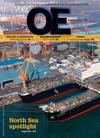
Page 124: of Offshore Engineer Magazine (Aug/Sep 2014)
Read this page in Pdf, Flash or Html5 edition of Aug/Sep 2014 Offshore Engineer Magazine
ffshore engineering offers many opportunities, but it can be
O fraught with challenges as well.
Whether operating an oil rig, moni-
HSEQ toring a remote wind farm, building a marine pipeline or constructing a tidal
Building an offshore energy facility, safety and reliability have extra layers of complexity when work takes place up to hundreds of nautical
HSEQ ecosystem miles from shore.
Today, the various health, safety,
McMurdo Group’s Remi Julien discusses how diferent technologies environmental and quality (HSEQ) can converge to create a holistic ofshore safety solution.
policies implemented rely on disparate, fragmented, and, in many cases, anti- quated systems. Paper-based documents and maps are frequently used rather than software-based electronic forms and charts, standard defnition cameras are still used instead of high-defnition, infrared or night vision alternatives, or solutions from a multitude of providers just don’t work together effciently or accurately. Monitoring and ensuring the safety of activities offshore, as well as keeping an eye on any potential environ- mental impacts, also involves a vast array of services, including maritime search and rescue, traffc monitoring, maritime borders and zone surveillance, environ- mental protection services, and so on.
Too often, these services collect data independently and are not aware that sometimes they are processing the same information, reducing the ability to react effectively.
Due to the high costs involved in offshore oil and gas production and the potential risk to personnel safety, many oil companies, platform operators and rig owners use various asset protection systems to safeguard equipment and employees from a wide range of potential threats, from accidental collisions and illegal trespassing to intentional attacks.
An asset protection system can include feet management, intrusion detection, employee safety, and environmental (oil spill) protection equipment. However, they are often treated as separate, distinct assets, owned and implemented by differ- ent departments. Fleet management, for example, may be an IT-sponsored project whereas intrusion detection is security- led and employee/environmental safety might be more regulatory driven.
In addition, offshore personnel and equipment work together in a highly intricate environment. With many HSEQ
Shore-side command centers are the hub for ofshore communications and rescue coordination eforts.
Images from McMurdo Group.
August 2014 | OE oedigital.com 126 126_OE0814_McMurdo.indd 126 7/22/14 7:32 PM

 123
123

 125
125